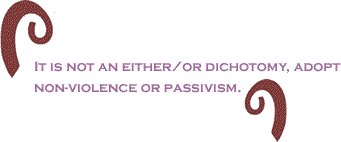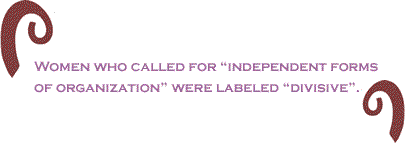|
|
| |
|
| |
|
| |
|
| |
|
| |
|
| |
When
I sat myself down to rest for a moment, so exhausted
I was ready to drop from the constant work for the cause,
I let my thoughts wander and I got the feeling that
I don’t have my own personal corner anywhere and that
nowhere do I exist and live as myself.
-Rosa
Luxemburg, The
Letters of Rosa Luxemburg
“The
problem of sexism within the New Left went a lot deeper,”
writes David Gilbert in My Life in SDS, the Weather
Underground, and Beyond. While the second wave of
feminism saw the rise of women articulating, as Gilbert
recalls, how women were oppressed and needed to join the
fight against all forms of oppression, many of us remember
the response to the November 1964 publication of “The
Position of Women in SNCC” from a prominently, much admired,
hard working Black activist, Stokely Carmichael, “the
position of women in SNCC is prone.”
Luckily
for us, Ella Baker slept at night and did her work for
SCLC and SNCC upright, during the day. But, as we now
know, there were women here and there who accepted Carmichael’s
retort and surrounded Dr. King and many other men on the
Left - in a prone position, of course.

Radical
feminist organizations continued to form by the spring
of 1967, and as Gilbert recalls, the concept of women’s
liberation reached SDS. At its first women’s caucus in
June, activist Marilyn Buck rose to the stage and spoke
while men in the audience “hooted and whistled.” Paper
planes floated toward Buck, and someone shouted at her,
“I’ll liberate you with my cock.” “A gem,” writes Gilbert,
for if only these crude comments were exceptional rather
than typical.
How
many on the Left mourned Marilyn Buck’s death in 2010
by recalling her struggles not only against the system
but within the Left, the so-called opposition to oppressive
thoughts and actions?
David
Gilbert is still an activist even while facing life at
Auburn Correctional Facilities in New York. He remembers,
and his struggle to “grapple” with the direction he is
taking, is ours. His guiding questions are our guiding
questions: “How does or doesn’t this particular path advance
the interests of the oppressed?” “What self-interests
do I have here and how do they complement or conflict
with the goals of the struggle?”

At
times while I read Gilbert’s Love and Struggle,
I remembered Amaze, and how we stood outside the building
complex where I lived on campus in Ethiopia wondering
how she, a tired woman, would make it home to an area
of corrugated homes off campus. She worked longer than
usual that day for the four faculty members she cooked,
cleaned, and washed clothes for everyday. As I walked
with her a few steps, I saw another Ethiopian in a pick
up. I waved to him and asked if he could take Amaze at
least to the campus gate some distance away.
“No,”
he said. “She can walk!”
He
turned the key and drove off as I looked at Amaze. She
did not look at me, but she straightened her back, hugged
me, and characteristically waved, “Ciao.” And she walked.
I
saw her the next morning as she walked toward the complex,
a bucket of water in one hand and with the other just
touching the bucket held firmly on her head. This was
a few years ago, and I imagine Amaze walking in a very
public corner.
 In
the U.S., the podiums and stages of Leftist gatherings
still honor the voices and “expertise” of men with a few
notable white women thrown in for a display of “diversity.” In
the U.S., the podiums and stages of Leftist gatherings
still honor the voices and “expertise” of men with a few
notable white women thrown in for a display of “diversity.”
The
Amazes anywhere are never asked to attend and speak about
gentrification, foreclosure, inadequate health care and
food supply or the devastating daily encounters of sexism
among the oppressed.
The
“anti-imperialist Left” of the 1960s and early 1970s,
writes Gilbert, with its “predominately white women’s
movement” and rampant sexism, distanced itself from frontline
national liberation struggles and gravitated toward defining
women’s issues from a white and often middle-class perspective.
It is no wonder that younger generation of women, with
limited knowledge about any history, let alone the 1960s
an 1970s, think of “free love” when I have mentioned the
women’s movement. Free love, Gilbert notes, served as
a tool “to make women sexually available rather than as
an opening to let love and equality flourish.”

Sexism
was on the national agenda, but organizations like the
old-line Marxist Progressive Labor Party “saw class as
the fundamental contradiction, with problems like racism
and sexism as secondary.” Such organizations agreed that
opposition to “male chauvinism” was in order, but “male
chauvinism” raises no eyebrows, and, as Gilbert notes,
limits the problem to “the realm of ideas and culture,”
which obscures the “fundamental structural problem” that
pointed to “oppression within the working class and the
Left.” Consequently, women who called for “independent
forms of organization” were labeled “divisive.”
When
finally the Left took up the campaign for women’s liberation,
the “problem” was labeled “male supremacy…a systematic
power structure who origins preceded capitalism and played
a control role in shaping society.”
At
the 1969 SDS National Convention, Gilbert describes the
atmosphere as intense, and battles for leadership positions
between the Progressive Labor Movement, SDS, and the Black
Panther Party were “fought over intensely.” Gilbert and
others anticipated the “widely-revered” Black Panther
Party’s address to the convention. It starts out great,
Gilbert recalls, until a spokesman for the BPP, when asked
about women’s liberation, “dismissed it as ‘pussy power.’”
Oh,
the good ole days of struggle! No wonder young people
today, predominately in the Western world, admire the
creation of Lady Gaga and fewer still objected to the
tabloid’s reference to Beyonce’s “baby bump.”
Today’s
liberated woman is not in any danger of falling
prey to reflecting on the conditions that find them existing
“nowhere” since so many men “love” when so many women
are “prone.”
By
the time the sexism of the good ole days of the 1960s
and 1970s became the norm, “a macho concept of struggle”
was in place. The “humanistic basis for our militancy
got lost,” Gilbert admits. It is not an either/or dichotomy,
adopt non-violence or passivism. Rather Gilbert asks us
to recognize how and why the “militarist direction was
wrong, morally and strategically.” It filed the prisons
and the graves with the young but did what for the older
Amaze or prevented the murder of Eleanor Bumpurs by police
ordered to evict her.
While
the leadership of SDS believed that “armed propaganda,”
- “actions designed to educate about the oppressor and
to show that there are ways to fight back without being
crushed” - would be a more effective way of for white
youth to achieve a level of struggle beneficial to the
oppressed, SDS’s tactics sought “military victories.”
The
Storms Troopers did arrive, however. They were effective!
They have become the State! And our liberated
are identified by the insignia they wear on clothing
designed predominantly by men who admire the objects they
cover with their fabrics and their visions. Hollow “liberation,”
purchased at Macy’s, J.P. Penny’s, Target, Wal-Mart, as
the liberated are informed not by the experiences
and resistance activism of Annie Mae Aquash or Bessie
Head, but by corporate-sponsored entertainers and corporate-think
educational institutions. Some women want to suit up in
camouflage and army boots, tote an M-16 rifle, and help
the U.S. Empire kill mostly women and children. Take our
history of struggle out of the classroom across the U.S.,
from K-12 and at the so-called higher institutions of
learning, and what do you have: Corporate liberation!
Yes,
the times they are a changin’, we are told, and even Dylan’s
back, supporting the Zionists’ oppression of Palestinian
women and children.
The
magnanimous explanation that I ought not to worry myself
over practical maters, because they’re already being
taken care of without me - only a person who doesn’t
know me at all could hand that out. (Rosa Luxemburg
to Leo Jogiches, Paris, March 25, 1894)
Others,
Rosa Luxemburg continues, with “weak nerves” might not
worry…
But
as far as I’m concerned, such a mode of operation -
with the word “little bird” being thrown in on top of
everything - to me that’s an insult, to put it mildly.
Add to that the crass, heavy-handed instructions: Do
such-and-such with Adolf [Geck], conduct yourself in
such-and-such a way when you visit Lavrov, stop doing
this or keep doing that - when it’s all put together
it leaves a single, indelible impression on me, a feeling
of uneasiness, fatigue, exhaustion, and restlessness
that comes over me in moments when I have time to think
about it.
I
wonder what a thinkers and activists such as Luxemburg,
a woman who served time in prison for the cause before
she was captured and executed in January, 1919, would
think about the progress of the Left in the U.S.

Where
are the revolutionaries? Where are the revolutionary men
and women? What Left movement would permit the
struggle of more women to provide protection for their
children in war zones, to locate water not contaminated
by U.S. oil companies, and to feed children with virtually
no income (as I witnessed in Ethiopia) while their governments
receive millions for the development of armies and surveillance
technology? Or would Luxemburg consider the Left’s contentment
with the so-called “sexual revolution” a victory for humanity?
No
revolution developed as a result of “free love”
and misogyny. So what do the men as well as the women
who submit to patriarchy fear?
“For
revolutionaries,” Gilbert writes, “our prime focus is
on the consciousness and mobilization of the people.”
I
agree. Revolutionaries do not exclude the voices, the
minds, the experiences and daily struggles, small “s”
of women, reinforcing male supremacy, witnessed in the
perpetual drumming of warmongers and in the corporate
shuffling and destruction of Indigenous, Black, Brown,
and Yellow lives. Revolutionaries, to use Luxemburg’s
words, must reject “imperialism and militarism in all
their forms” - “a real and proper rejection that is meant
seriously this time, and that would apply even in the
event of war.”
Revolutionaries
make the seemingly impossible--possible!
When
i read the book about Black women, i felt the spirits
of those sisters feeding me, making me stronger. Black
women have been struggling and helping each other to
survive the blows of life since the beginning of time.
And when i read Siddhartha, a peace came over me. i
felt a unity with all things living. The world, in spite
of oppression, is a beautiful place. i would say ‘Om’
softly to myself, letting my lips vibrate. i felt the
birds, the sun, and the trees. i was in communion with
all the revolutionary forces on the earth.
BlackCommentator.com Editorial Board member, Lenore Jean Daniels, PhD, has a Doctorate
in Modern American Literature/Cultural Theory. Click here to contact Dr. Daniels.
|
| |
|
| |
|
| |
|
| |
|
| |
|
If you send
us an emaill message we may publish all or part
of it, unless you tell us it is not for publication.
You may also request that we withhold your name.
Thank you
very much for your readership.
|
| |
|
| |
|
| |
|
| Feb 9, 2012 - Issue 458 |
 is
published every Thursday
is
published every Thursday |
| Est. April 5, 2002 |
Executive Editor:
David A. Love, JD |
Managing Editor:
Nancy Littlefield, MBA |
Publisher:
Peter Gamble |
| |
|
| |
|
|
|
| |
| |
| |
| |
| |
| |
| |
| |
| |
| |
|
|

